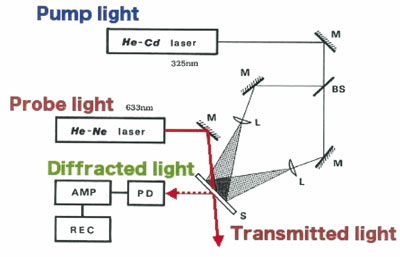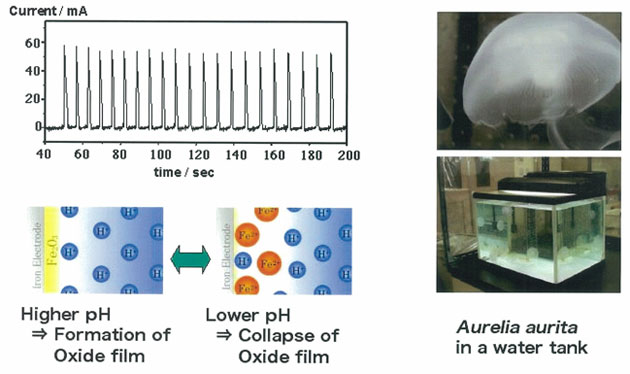| Principal research topics: |
 |
(1) |
Correlative analysis of the functional structure of interfaces and materials with light-optical functions that utilize non-linear optical effects |
|
Outline: |
Optical second harmonic generation (SHG), due to its ability to exhibit specific responses in interfaces that have no inversion symmetry, is effective in investigating molecular structures arranged on differently phased interfaces such as Langmuir-Blodgett (LB) films or Self-assembly (SA) films. Using these methods students pursue the structure of molecular films including the thiol and azobenzene derivatives that indirectly support nanotechnology from within molecular engineering, as well they investigate such areas as the interaction with single-crystal metals and semiconductors used in the substrates of these films, and the pioneering of new functionalities. |
|
 |
|
Figure 1. SHG rotational anisotropy observed at Au (111) surface modified by thiol SA film |
 |
 |
(2) |
Understanding of the various phenomena involving light in electrochemical interfaces, and investigation toward future functional use of these phenomena |
|
Outline: |
An electrochemical interface is a reaction field that involves electron and mass transfer. This reaction field not only includes the macroscopic solid/liquid interfaces between solutions and metal or semiconductor electrodes, but also includes gas/solid or liquid/solid interfaces with such materials as semiconductor particles, molecular ultra-thin films, colloids, clusters, and microcrystals. Our group carries out investigations by explaining the reaction dynamics and the changes in structures and properties of various light-involving phenomena that transcend these size-related hierarchies in electrochemical interfaces. We engage in, for instance, studies on the advanced functioning and the improvement of reactivity of semiconductor photocatalysts. |
 |
 |
(3) |
Pioneering new optical sensing methods for environmental monitoring |
|
Outline: |
To realize the advanced functionality and the improvement of reactivity of semiconductor photocatalysts, which are expected to be a softer form of environmental clean-up technology, it will be necessary to develop methods that offer on-the-spot real time monitoring of the semiconductor surface as the reaction field. Our group has developed a holographic method of monitoring the reaction field by closely observing the distribution of the optical constant. Due to its applicability to the detection of such substances as inflammable and poisonous gases we have on-going studies investigating its possibilities as a new highly responsive sensing method for environmental monitoring. |
|
 |
|
Figure 2. Holographic surface monitoring using optical interferometry |
 |
 |
(4) |
Elucidation and controlling of reaction mechanisms in non-linear electrochemical reactions |
|
Outline: |
Self-oscillation of current occurs when an iron electrode undergoes controlled potential in a sulfuric acid solution. Electrochemical non-linear oscillators such as these are non-linear chemical systems that can be controlled by electrochemical means, and as such they can act as models for systems exhibiting a variety of complex responses including brain, organism, industrial plant systems, and so on. Our group studies the elucidation and the controlling of the reaction mechanisms in non-linear electrochemical systems by the vehicle of joint research with researchers at other universities. This includes such research as visualization of model systems or observation of responses within a strong magnetic field induced by a superconducting magnet. |
|
 |
|
Figure 3. Non-linear electrochemical oscillators and biological chaos: Can a solution for the power generation plant and ship water-intake problems stemming from jellyfish population explosions really be found?! |